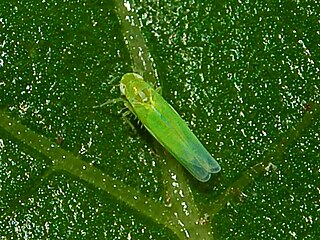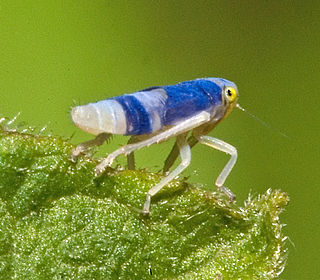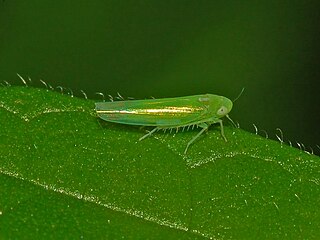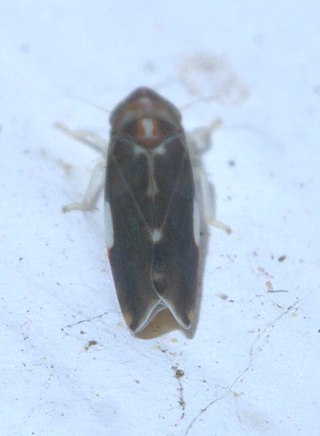
Leafhopper is the common name for any species from the family Cicadellidae. These minute insects, colloquially known as hoppers, are plant feeders that suck plant sap from grass, shrubs, or trees. Their hind legs are modified for jumping, and are covered with hairs that facilitate the spreading of a secretion over their bodies that acts as a water repellent and carrier of pheromones. They undergo a partial metamorphosis, and have various host associations, varying from very generalized to very specific. Some species have a cosmopolitan distribution, or occur throughout the temperate and tropical regions. Some are pests or vectors of plant viruses and phytoplasmas. The family is distributed all over the world, and constitutes the second-largest hemipteran family, with at least 20,000 described species.

The Auchenorrhyncha suborder of the Hemiptera contains most of the familiar members of what was called the "Homoptera" – groups such as cicadas, leafhoppers, treehoppers, planthoppers, and spittlebugs. The aphids and scale insects are the other well-known "Homoptera", and they are in the suborder Sternorrhyncha.

The superfamily Membracoidea of sap-sucking true-bugs includes two of the largest families within what used to be called the "Homoptera": the leafhoppers (Cicadellidae) and the treehoppers (Membracidae). The other families in this group are quite small, and have, at various points, generally been included as members within other families, though they are all presently considered to be valid, monophyletic groups. The relict family Myerslopiidae is restricted to New Zealand and South America while the Melizoderidae consist of two genera restricted to South America. The great diversity of Neotropical taxa suggests that the group originated in that region.
David Allan Young Jr., was an American entomologist who specialized in the taxonomy of the Cicadellidae and authored a comprehensive treatment of the family with numerous genera and species described and named by him. This work in three parts Taxonomic Study of the Cicadellinae covered 292 genera.

Empoasca decipiens is a species of leafhopper belonging to the family Cicadellidae subfamily Typhlocybinae. The adults reach 3–4 millimetres (0.12–0.16 in) of length and a are homogenously green with whitish markings on its pronotum and vertex. E. decipiens is commonly referred to as the “green leafhopper” because of its colouration. The absence of clear stripes along the forewings can easily distinguish it from the similar leafhopper species E. vitis, but distinguishing it from other leafhoppers with the same colouration requires examination under a microscope. It is present in most of Europe, in the eastern Palearctic realm, in North Africa, in the Near East, and in the Afrotropical realm. Both nymphs and adults of this small insect are considered to be a very destructive pests on field crops, vegetables and greenhouse plants.
Sweta is a genus of leafhopper in the subfamily Typhlocybinae, with two species. The genus name is derived from the Sanskrit word for white, the type species S. hallucinata being predominantly whitish. The genus has an elongate pronotum which is unusual in Typhlocybinae and seen only in the Signoretiinae. A second species Sweta bambusana was described from China in 2012.

Typhlocybinae is a subfamily of insects in the leafhopper family, Cicadellidae. This is currently the second largest leafhopper subfamily based on the number of described species, but researchers believe there are so many taxa yet undescribed that it is probably the largest subfamily. Approximately 6000 species have been described thus far.

Empoascini is a tribe of leafhoppers in the subfamily Typhlocybinae.

Dikraneurini is a leafhopper tribe in the subfamily Typhlocybinae.

Potato leafhopper belongs to family Cicadellidae and genus Empoasca within order Hemiptera. In North America they are a serious agricultural pest. Every year millions of dollars are lost from reduced crop yields and on pest management. Crops that are impacted the most are potatoes, clover, beans, apples and alfalfa.

Agallia is a genus of leafhoppers in the family Cicadellidae. There are about 8 described species in Agallia. During courtship displays and mating, both males and females of the species A. constricta alternate in making ticking sounds.

Erythroneura infuscata, commonly known as Leafhopper, is a species of leafhopper in the family Cicadellidae.

Coelidiinae is a subfamily of leafhoppers in the family Cicadellidae. There are at least 8 tribes, 108 genera, and over 900 species in Coelidiinae.

Paraphlepsius irroratus, known generally as bespeckled leafhopper, is a species of leafhopper in the family Cicadellidae. Other common names include the irrorate leafhopper and brown-speckled leafhopper.
Mileewinae is a small subfamily in the family Cicadellidae (leafhoppers). It is closely related to Typhlocybinae and contains species that were previously part of Cicadellinae.

Chandrashekaraswami Adiveyya Viraktamath is an Indian entomologist who specializes in the systematics of leaf-hoppers, Cicadellidae. He served as a professor of entomology at the University of Agricultural Sciences, Bangalore.
Acinopterini is a tribe of leafhoppers in the subfamily Deltocephalinae. Acinopterini is made up of 2 genera over 35 species. Acinopterus is widely distributed throughout North and South America with more than 30 species; Cariancha and its two species are endemic to Brazil.
Irena Dworakowska is a Polish entomologist who specialized in hemipterology.

Erasmoneura vulnerata is a species of leafhopper native to North America. The species was found to be in Europe in 2004 where it causes significant economic damage to grapevine yards. E. vulnerata is commonly found on wild and cultivated grapes from both continents. Its Latin name translates to "wounded Erasmoneura" from its original description.
Bhandara is a genus of leafhoppers, found in Southeast Asia. The genus was first identified by English entomologist, William Lucas Distant, in 1908.














